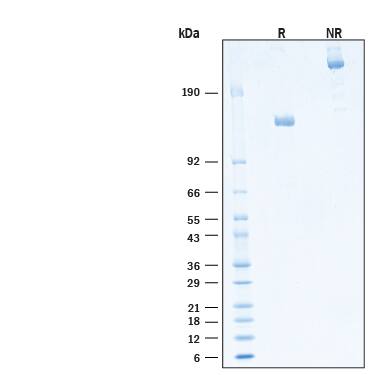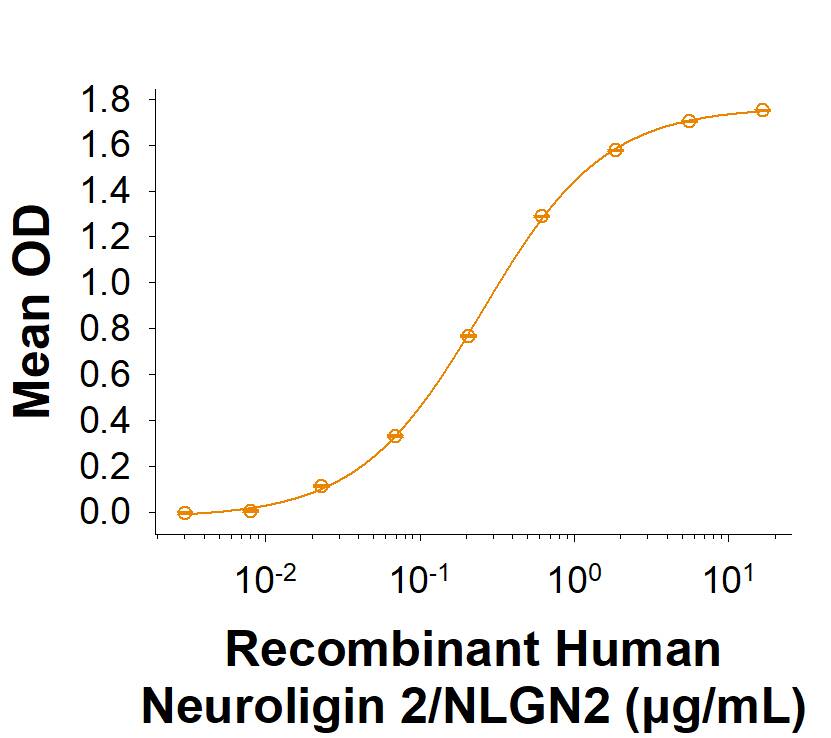Recombinant Human MDGA1 Fc Chimera Protein, CF
R&D Systems, part of Bio-Techne | Catalog # 11368-MD

Key Product Details
Source
HEK293
Accession #
Structure / Form
Disulfide-linked homodimer
Conjugate
Unconjugated
Applications
Bioactivity
Product Specifications
Source
Human embryonic kidney cell, HEK293-derived human MDGA1 protein
| Human MDGA1 (Gln19-Gly931) Accession # Q8NFP4.1 |
IEGRMD | Human IgG1 (Pro100-Lys330) |
| N-terminus | C-terminus |
Purity
>95%, by SDS-PAGE visualized with Silver Staining and quantitative densitometry by Coomassie® Blue Staining.
Endotoxin Level
<0.10 EU per 1 μg of the protein by the LAL method.
N-terminal Sequence Analysis
No results obtained: Gln19 predicted
Predicted Molecular Mass
128 kDa
SDS-PAGE
125-145 kDa, under reducing conditions.
Activity
Measured by its binding ability in a functional ELISA.
When Recombinant Human MDGA1 Fc Chimera (Catalog # 11368-MD) is immobilized at 1 µg/mL (100 µL/well), Recombinant Human Neuroligin 2/NLGN2 (Catalog # 5645-NL) binds with an ED50 of 0.125-1.50 µg/mL.
When Recombinant Human MDGA1 Fc Chimera (Catalog # 11368-MD) is immobilized at 1 µg/mL (100 µL/well), Recombinant Human Neuroligin 2/NLGN2 (Catalog # 5645-NL) binds with an ED50 of 0.125-1.50 µg/mL.
Scientific Data Images for Recombinant Human MDGA1 Fc Chimera Protein, CF
Recombinant Human MDGA1 Fc Chimera Protein Binding Activity.
When Recombinant Human MDGA1 Fc Chimera Protein (Catalog # 11368-MD) is immobilized at 1 µg/mL (100 µL/well), Recombinant Human Neuroligin 2/NLGN2 (5645-NL) binds with an ED50 of 0.125-1.50 µg/mL.Recombinant Human MDGA1 Fc Chimera Protein SDS-PAGE.
2 μg/lane of Recombinant Human MDGA1 Fc Chimera Protein (Catalog # 11368-MD) was resolved with SDS-PAGE under reducing (R) and non-reducing (NR) conditions and visualized by Coomassie® Blue staining, showing bands at 125-145 kDa and 250-290 kDa, respectively.Formulation, Preparation and Storage
11368-MD
| Formulation | Lyophilized from a 0.2 μm filtered solution in PBS with Trehalose. |
| Reconstitution | Reconstitute at 500 μg/mL in PBS. |
| Shipping | The product is shipped at ambient temperature. Upon receipt, store it immediately at the temperature recommended below. |
| Stability & Storage | Use a manual defrost freezer and avoid repeated freeze-thaw cycles.
|
Background: MDGA1
References
- Litwack, E.D. et al. (2004) Mol. Cell. Neurosci. 25:263.
- Diaz-Lopez, A. et al. (2005) Exp. Cell Res. 307:91.
- De Juan, C. et al. (2002) Oncogene 21:3089.
- Ishikawa, T. et al. (2011) Dev. Dyn. 240:96.
- Takeuchi, A. and D.D.M. O'Leary (2006) J. Neurosci. 26:4460.
- Takeuchi, A. et al. (2007) Cereb Cortex. 17:1531.
- Fujimura, Y. et al. (2006) Brain Res. 1101:12.
- Diaz-Lopez, A. et al. (2011) Cancer Microenviron. 4:23.
Long Name
MAM Domain Containing Glycosylphosphatidylinositol Anchor 1
Alternate Names
GPIM, MAMDC3
Gene Symbol
MDGA1
UniProt
Additional MDGA1 Products
Product Documents for Recombinant Human MDGA1 Fc Chimera Protein, CF
Product Specific Notices for Recombinant Human MDGA1 Fc Chimera Protein, CF
For research use only
